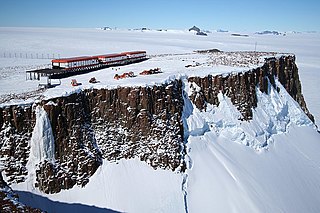The Desko Mountains are a west-northwest–east-southeast mountain range on Rothschild Island, off northwest Alexander Island. The mountain range spans 20 nautical miles (37 km) from Bates Peak to Overton Peak and rises to about 1,000 metres (3,300 ft) at Enigma Peak, Fournier Ridge.
Bråpiggen Peak is one of the ice-free peaks at the south side of Antarctica's Frostlendet Valley, situated 1 nautical mile (2 km) south of Friis-Baastad Peak in the Borg Massif of Queen Maud Land. It was mapped by Norwegian cartographers from surveys and from air photos by the Norwegian–British–Swedish Antarctic Expedition (1949–52) and named "Bråpiggen".
Von Essen Mountain is a mountain, 2,665 m, marking the southwest end of the Gjelsvik Mountains in Queen Maud Land. Photographed from the air by the German Antarctic Expedition (1938–39). Mapped by Norwegian cartographers from surveys and air photos by Norwegian-British-Swedish Antarctic Expedition (NBSAE) (1949–52) and air photos by the Norwegian expedition (1958–59). Named for R.G.D.J. Von Essen, commander of the Swedish Air Force unit (1951–52) with the NBSAE.
The Jule Peaks are a small group of isolated peaks located about 35 nautical miles (65 km) west-northwest of Borg Mountain in Queen Maud Land, Antarctica. They were mapped by Norwegian cartographers from surveys and air photos by the Norwegian–British–Swedish Antarctic Expedition (1949–52), and named Juletoppane.
The Dekefjellrantane Hills are a group of rock hills at the southern end of the Weyprecht Mountains in Queen Maud Land. They were photographed from the air by the Third German Antarctic Expedition (1938–39). They were mapped by Norwegian cartographers from surveys and air photos by the Sixth Norwegian Antarctic Expedition (1956–60) and named Dekefjellrantane in association with nearby Dekefjellet Mountain.
Kvithø Peak is an isolated peak rising above the ice 7 nautical miles (13 km) southeast of Kvitkjolen Ridge, in the Sverdrup Mountains of Queen Maud Land, Antarctica. It was photographed from the air by the Third German Antarctic Expedition (1938–39). The peak was mapped by Norwegian cartographers from surveys and air photos by the Norwegian–British–Swedish Antarctic Expedition (1949–52) and air photos by the Norwegian expedition (1958–59) and named Kvithø.
Kvasstind Peak is a peak in the northeast part of Borg Mountain, in the Borg Massif of Queen Maud Land, Antarctica. It was mapped by Norwegian cartographers from surveys and air photos by the Norwegian–British–Swedish Antarctic Expedition (1949–52) and named Kvasstind.
Friis-Baastad Peak is one of the ice-free peaks at the south side of Frostlendet Valley, situated 1 nautical mile (2 km) southeast of the Mana Mountain in the Borg Massif of Queen Maud Land, Antarctica. It was mapped by Norwegian cartographers from surveys and air photos by Norwegian–British–Swedish Antarctic Expedition (NBSAE) (1949–52) and named for Captain Kare Friis-Baastad, a member of the Norwegian air unit with the NBSAE.
Dugurdspiggen Peak is an isolated peak about 4 nautical miles north of the Borg Massif in Queen Maud Land. It was mapped by Norwegian cartographers from surveys and air photos by Norwegian–British–Swedish Antarctic Expedition (1949–52) and from air photos by the Norwegian expedition (1958–59) and named Dugurdspiggen.
Isingen Mountain is a large icecapped mass, through which protrude several rock peaks, between Ising Glacier and Rogstad Glacier in the Sverdrup Mountains of Queen Maud Land, Antarctica. It was photographed from the air by the Third German Antarctic Expedition (1938–39). It was mapped by Norwegian cartographers from surveys and air photos by the Norwegian–British–Swedish Antarctic Expedition(1949–52) and from air photos by the Norwegian expedition (1958–59) and named Isingen.
The Gösta Peaks are the northeastern peaks of the Liljequist Heights, in the southern part of Ahlmann Ridge in Queen Maud Land, Antarctica. They were mapped by Norwegian cartographers from surveys and air photos by the Norwegian–British–Swedish Antarctic Expedition (NBSAE) (1949–52) and from air photos by the Norwegian expedition (1958–59), and were named for Gösta Hjalmar Liljequist, a Swedish meteorologist with the NBSAE.

Hålisen Glacier is a cirque glacier between Halisrimen Peak and Halisstonga Peak in the Kurze Mountains of Queen Maud Land, Antarctica. It was mapped by Norwegian cartographers from surveys and air photos by the Sixth Norwegian Antarctic Expedition (1956–60) and named Hålisen.
Midbresrabben Hill is an isolated rock hill protruding above the ice between Penck Trough and Jutulstraumen Glacier, east of the Borg Massif in Queen Maud Land, Antarctica. It was mapped by Norwegian cartographers from surveys and air photos by the Norwegian–British–Swedish Antarctic Expedition (1949–52) and from air photos by the Norwegian expedition (1958–59) and named "Midbresrabben".
Hatten Peak is an isolated rock peak 6 nautical miles (11 km) northwest of Veten Mountain, rising above the ice at the northwest side of Borg Massif in Queen Maud Land, Antarctica. It was mapped by Norwegian cartographers from surveys and air photos by the Norwegian–British–Swedish Antarctic Expedition (1949–52) and named Hatten.
Skaret Pass is a mountain pass at the east side of Skarsnuten Peak in the Roots Heights, Sverdrup Mountains, in Queen Maud Land. Photographed from the air by the German Antarctic Expedition (1938–39). Mapped by Norwegian cartographers from surveys and air photos by Norwegian-British-Swedish Antarctic Expedition (NBSAE) (1949–52) and air photos by the Norwegian expedition (1958–59) and named Skaret.
Høgsaetet Mountain is a 2,717-metre (8,914 ft) tall mountain just northeast of Raudberget in the Borg Massif of Queen Maud Land, Antarctica. It was mapped by Norwegian cartographers from surveys and air photos by the Norwegian–British–Swedish Antarctic Expedition (1949–52) and named Høgsætet.
The Liljequist Heights are the heights about 2 nautical miles (4 km) south of the Grunehogna Peaks, in the Ahlmann Ridge of Queen Maud Land, Antarctica. They were mapped by Norwegian cartographers from surveys and air photos by the Norwegian–British–Swedish Antarctic Expedition (NBSAE) (1949–52) and air photos by the Norwegian expedition (1958–59). The heights are named for Gösta Hjalmar Liljequist, a Swedish meteorologist with the NBSAE.




